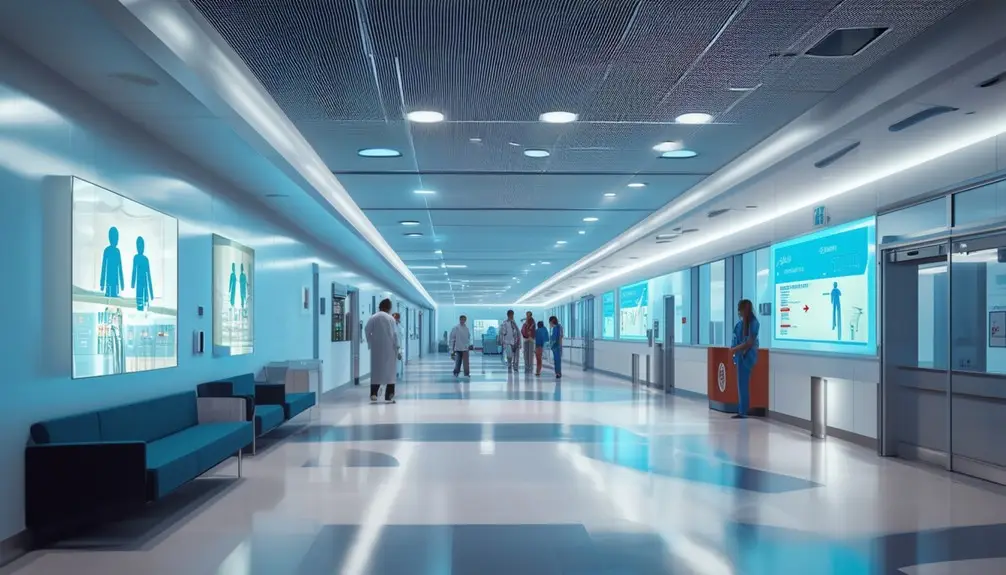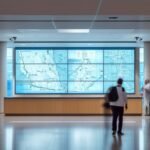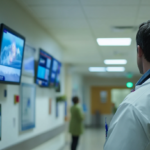Digital hospital signage drastically enhances navigation within healthcare facilities. You’ll benefit from clear, multilingual directions and real-time updates, reducing patient stress and boosting satisfaction. Interactive kiosks and mobile apps provide personalized routes and emergency messages, making navigation intuitive and inclusive. High-resolution digital signs offer efficient, ADA-compliant communication, cutting down perceived wait times and improving overall experience. Hospitals like John Hopkins and Boston Children’s show significant improvements in patient flow and satisfaction using these technologies. For further insights on how digital wayfinding transforms hospital experiences, your next step is just ahead.
Key Takeaways
- Digital signage provides real-time updates and interactive maps to enhance hospital navigation.
- Multilingual support on digital signs ensures inclusivity and better navigation for diverse patient populations.
- Mobile apps integrated with digital wayfinding offer turn-by-turn directions and appointment schedules.
- Interactive kiosks deliver personalized directions and emergency messaging for intuitive navigation.
- High-resolution digital signs reduce perceived wait times and improve the overall hospital experience.
Understanding Hospital Wayfinding
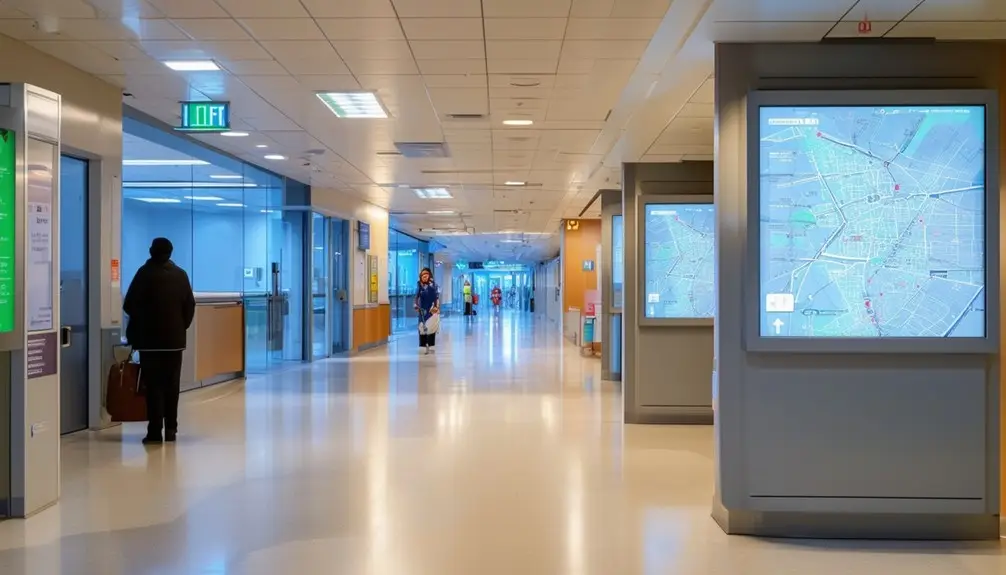
Getting around a hospital can be intimidating, but understanding hospital wayfinding systems is crucial for ensuring smooth and efficient movement within these complex environments. Hospital wayfinding encompasses the guiding of patients, visitors, and staff within these intricate facilities. Effective wayfinding systems utilize digital signage and interactive maps to direct you through various departments, enhancing your overall experience.
In the healthcare sector, digital wayfinding is vital for enhancing patient satisfaction and operational efficiency. Digital signage provides clear, real-time directions and essential information, reducing the stress of finding your way in unfamiliar spaces. Interactive maps, accessible via kiosks or mobile apps, offer step-by-step guidance, ensuring you reach your destination without confusion. These tools are particularly significant during emergencies, where instant messaging can direct you swiftly to safety.
Hospitals employ spatial problem-solving techniques, including strategic use of colors, lights, and building layouts to facilitate orientation. By integrating these elements with digital solutions, healthcare facilities can notably improve accessibility and user experience. Multi-lingual support and voice-activated assistants further enhance the inclusivity of these systems, making it easier for everyone to find their way.
Understanding hospital wayfinding is key to efficiently navigating medical facilities, ensuring you receive timely care and reducing overall stress.
Components of Digital Wayfinding
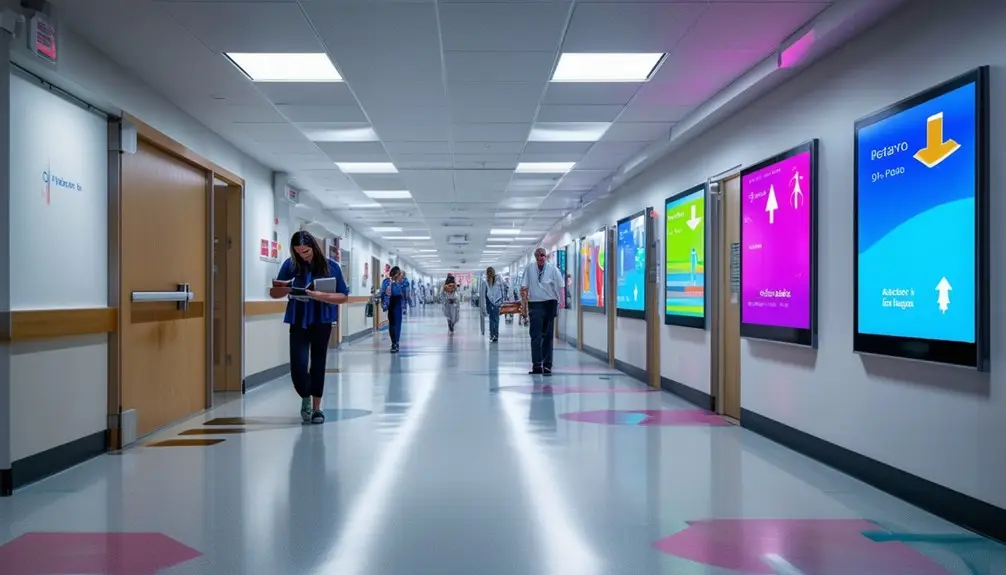
When implementing digital wayfinding in hospitals, you’ll benefit from understanding the key components like interactive kiosks, mobile apps, and digital signs. Each element offers distinct advantages: kiosks provide on-the-spot assistance, apps integrate with personal devices for convenience, and digital signs deliver real-time updates. These technologies work together to streamline navigation and enhance the user experience.
Interactive Kiosks Benefits
Interactive kiosks are essential in digital wayfinding, offering multi-lingual support, emergency messaging, and personalized directions to enhance hospital navigation. These kiosks provide a seamless, intuitive navigation experience for visitors, guaranteeing they can easily find their way around the hospital. By catering to diverse user needs through multi-lingual support, they break down language barriers, making the hospital more accessible to everyone.
Emergency messaging capabilities are another vital feature. In urgent situations, these kiosks can disseminate important information quickly and efficiently, ensuring that all visitors and staff are aware of important updates. Personalized directions further enhance the visitor experience by providing specific, step-by-step guidance to desired locations within the hospital. This level of detail reduces confusion and stress, particularly for those unfamiliar with the facility.
Additionally, interactive kiosks offer advanced wayfinding solutions by integrating real-time updates on appointments, events, and facility maps. This guarantees that visitors have the most current information at their fingertips, streamlining their journey through the hospital. By combining these features, interactive kiosks greatly improve hospital navigation and overall visitor satisfaction, setting a new standard for digital wayfinding in healthcare environments.
Mobile Apps Integration
Mobile apps, central to digital hospital signage, offer personalized navigation assistance and real-time updates on your smartphone, enhancing the wayfinding experience in complex hospital environments. By integrating these apps, hospitals provide turn-by-turn directions, interactive maps, and multi-lingual support, ensuring seamless navigation for patients and visitors alike.
With mobile apps, you can access real-time updates on appointment schedules, department locations, and even emergency messaging, making your hospital visit more efficient and less stressful. These apps don’t just improve your wayfinding experience; they also optimize operational efficiency in healthcare facilities by reducing the need for physical signage and staff assistance.
For a clearer understanding, consider the following table highlighting key features:
| Feature | Benefit | Impact |
|---|---|---|
| Personalized Navigation | Tailored directions | Enhanced user experience |
| Real-Time Updates | Up-to-date information | Increased efficiency |
| Turn-by-Turn Directions | Step-by-step guidance | Reduced stress |
| Interactive Maps | Easy location finding | Improved satisfaction |
Digital Signs Efficiency
Digital signs, central to modern hospital wayfinding systems, offer high-resolution maps, real-time updates, and emergency messaging to enhance navigation efficiency. When you walk into a hospital, these digital signage solutions guide patients and visitors seamlessly through complex facilities. They provide clear navigation information, reducing confusion and stress.
Operational efficiency is greatly boosted by digital signage. Hospitals save on printing costs and streamline staff workflows as real-time updates eliminate the need for frequent manual changes. This means your staff can focus more on patient care rather than administrative tasks.
Effective communication is another important advantage. Digital signs deliver important information quickly and accurately, helping manage patient flow and reducing perceived wait times by up to 35%. In emergencies, these signs can disseminate vital messages instantly, safeguarding everyone’s safety.
Inclusivity is also addressed as digital signs meet ADA requirements and support multiple languages. This ensures that all patients, including those with disabilities, can navigate the hospital independently. By enhancing wayfinding and communication, digital signage ultimately improves the overall hospital experience for patients, visitors, and staff alike, making it an essential tool for operational efficiency.
Benefits of Digital Wayfinding
Incorporating digital wayfinding signage in hospitals greatly enhances patient experience and satisfaction, with improvements reaching up to 70%. Digital signage systems reduce perceived wait times by 35%, making your hospital more efficient. These wayfinding systems provide real-time updates on appointments and schedules, notably improving communication between staff and patients.
| Benefit | Description |
|---|---|
| Patient Experience | Enhances satisfaction by up to 70% |
| Perceived Wait Times | Reduces by 35% |
| Communication | Real-time updates improve staff-patient interaction |
| Multilingual Support | Caters to diverse patient populations |
Meeting ADA requirements and offering multilingual support, digital signage assures accessibility for all patients, including those with disabilities. This fosters an inclusive environment and helps everyone find their way efficiently. Additionally, these wayfinding systems enhance staff efficiency by streamlining navigation tasks, allowing healthcare professionals to focus more on patient care rather than directional assistance.
Adopting digital wayfinding signage boosts productivity by reducing the workload on staff and speeding up information dissemination. Improved navigation helps in quicker patient flow, which is essential for maintaining smooth hospital operations. Through technological sophistication and practical utility, digital wayfinding systems are an indispensable asset for modern healthcare facilities, ensuring everyone feels informed and guided.
Improving Hospital Navigation

How can the strategic use of colors, lights, and clear maps transform hospital wayfinding into a smooth experience for patients and visitors? By leveraging digital signage and advanced direction systems, hospitals can greatly enhance wayfinding and patient satisfaction. Colors and lights serve as key technical elements, guiding individuals through complex hospital facilities. For example, color-coded pathways and illuminated signs can delineate different departments, making it easier to find the desired location.
Interactive maps and mobile solutions are essential tools in modern hospital wayfinding. They provide real-time directions and spatial problem-solving capabilities, ensuring that patients and visitors can easily identify clear pathways. By integrating these digital direction systems, hospitals can anticipate the needs of users, reducing stress and confusion.
Clear maps positioned strategically within the hospital facilities offer a visual representation of the layout, further aiding wayfinding. Digital kiosks and mobile apps complement these maps, providing interactive and user-friendly solutions. The combination of these technical elements creates an environment where efficient wayfinding is achievable, thereby improving overall patient satisfaction. Ultimately, a well-designed direction system is vital for transforming the often overwhelming experience of finding one’s way through a hospital into a more manageable and pleasant one.
Enhancing Wayfinding With Technology
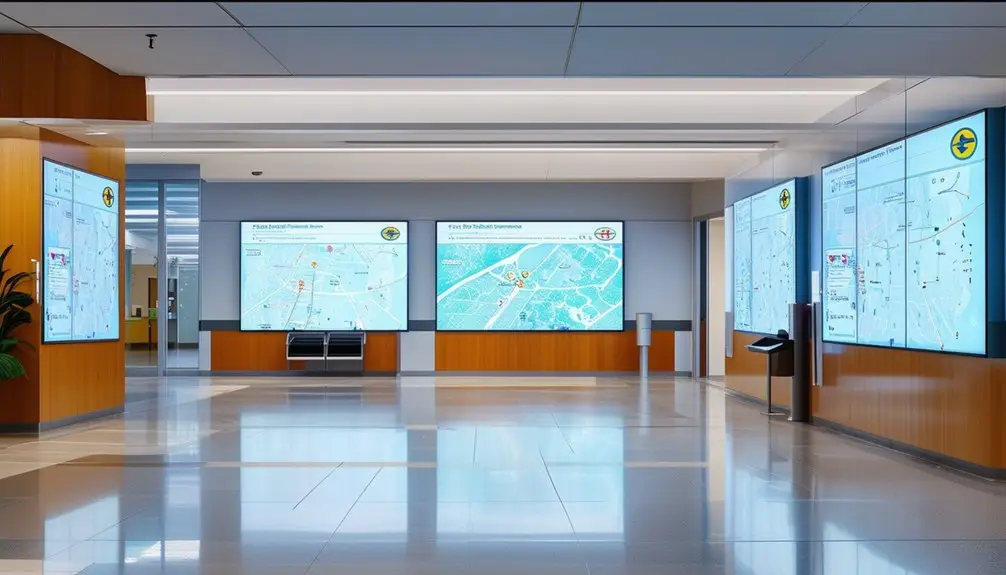
Frequently, hospitals leverage cutting-edge technology to enhance wayfinding, greatly improving the navigation experience for patients and visitors alike. By integrating digital signage, hospitals can provide real-time updates and multilingual support, making certain that everyone can easily find their way around.
Digital wayfinding systems not only boost patient satisfaction but also streamline operations, reducing staff workload and making navigation more cost-effective. Interactive kiosks and mobile apps are a prime example of how technology can transform hospital navigation. These tools can markedly reduce wait times—by up to 35%—and improve patient satisfaction by as much as 70%.
| Benefit | Impact on Hospital | Patient Experience |
|---|---|---|
| Digital Signage | Enhances communication | Clearer directions |
| Real-time Updates | Increases efficiency | Reduced wait times |
| Multilingual Support | Ensures inclusivity | Easier navigation for all |
| Streamline Operations | Reduces staff workload | Faster assistance |
| Cost-effective Solutions | Lowers operational costs | Improved overall service |
Strategic placement of digital signage guarantees compliance with ADA requirements and safety standards, further enhancing the overall experience. By adopting these advanced wayfinding systems, hospitals can markedly improve both operational efficiency and patient satisfaction, setting a new standard for healthcare facilities.
Case Studies of Digital Wayfinding
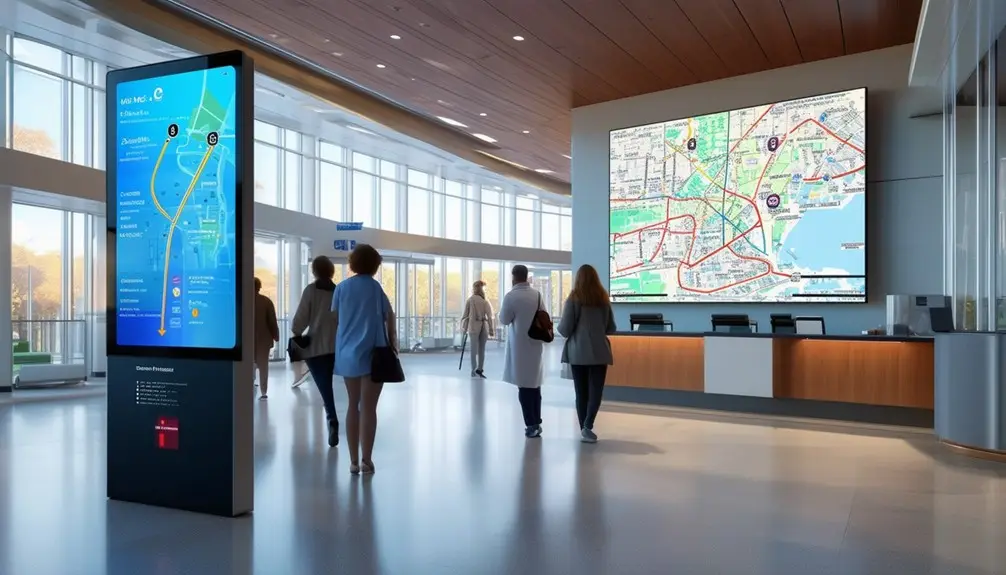
You’ll see how hospitals like John Hopkins and Boston Children’s have successfully implemented digital wayfinding solutions, including apps and kiosks. These technologies have not only reduced confusion but also greatly boosted patient satisfaction. By examining these real-world examples, you’ll gain insights into the tangible benefits and outcomes of adopting digital navigation systems.
Real-World Implementation Examples
Recently, hospitals like John Hopkins in Baltimore and Boston Children’s have successfully implemented digital wayfinding solutions, demonstrating significant improvements in patient navigation and satisfaction. At John Hopkins, the integration of digital signage and kiosks has streamlined the navigation within their complex facility. These digital wayfinding systems offer real-time navigation guidance, greatly enhancing patient experience and reducing stress associated with getting lost.
Boston Children’s has taken a step further by developing the MyWay app, which provides personalized navigation for patients and visitors. This app leverages advanced digital wayfinding technologies to guarantee that each individual receives tailored directions, contributing to improved navigation and overall patient satisfaction.
Meanwhile, Tallahassee Memorial Hospital in Florida has installed digital kiosks to assist patients and visitors in finding their way throughout the hospital. These kiosks provide easy-to-follow directions, helping to minimize confusion and enhance the overall patient experience.
Hospitals employing these digital wayfinding systems are witnessing a notable rise in patient satisfaction. The combination of digital signage and personalized navigation safeguards that patients and visitors can navigate healthcare facilities with ease, ultimately leading to a more positive and stress-free experience.
Observed Benefits and Outcomes
The successful implementation of digital wayfinding systems in hospitals like John Hopkins and Boston Children’s underscores the substantial benefits and measurable outcomes these technologies deliver. At John Hopkins Hospital, the introduction of digital signage and kiosks for wayfinding reduced visitor inquiries by 30% and boosted patient satisfaction. Similarly, Boston Children’s Hospital‘s MyWay app led to a 25% drop in missed appointments and a 20% increase in patient navigation efficiency.
Tallahassee Memorial Hospital saw a 40% decrease in wayfinding-related complaints and a 15% rise in staff productivity due to digital kiosks. These technologies enhance the patient experience and satisfaction by 70%, largely by reducing perceived wait times by 35%. Digital signage for hospitals offers real-time updates, ensuring smooth patient flows and timely appointment management.
Compliance with ADA requirements is streamlined through these systems, offering multilingual support and better accessibility. The observed outcomes strongly indicate that digital wayfinding systems improve navigation to a great extent, making it easier for patients and visitors to find their way, ultimately enhancing overall hospital efficiency and satisfaction. These case studies demonstrate that digital wayfinding is not just a technological upgrade but a strategic improvement in hospital operations.
Challenges and Innovations
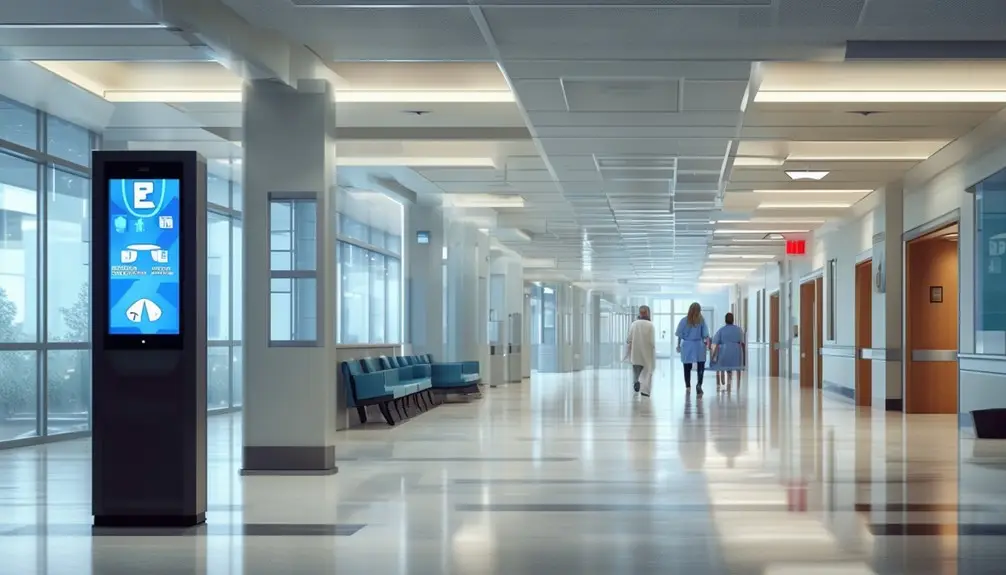
Expanding hospital facilities and the lack of standardized wayfinding solutions present significant challenges that digital signage aims to overcome. As hospitals grow, finding one’s way through these complex environments becomes increasingly difficult for patients and staff alike. Digital signage offers dynamic wayfinding solutions that can adapt to changing layouts and provide real-time information.
One of the most promising digital wayfinding innovations is the use of QR codes. By scanning a QR code, visitors can receive customized directions on their smartphones, minimizing confusion. Voice-activated solutions and touchless displays further enhance accessibility, allowing users to interact with the signage without physical contact. Location-aware technologies enable the system to provide precise directions based on the user’s current position, ensuring efficient guidance.
Integrating digital signage with building automation and access control systems can streamline hospital wayfinding. For example, real-time appointment reminders can be displayed, guiding patients directly to their next appointment. Customized pathways can be generated, taking into account current building operations and access restrictions. These innovations not only improve wayfinding but also enhance the overall operational efficiency of healthcare facilities.
Implementing these technologies, however, requires overcoming integration issues with existing healthcare systems and network infrastructure. Yet, the potential benefits make these challenges worth addressing.
Patient Experience Enhancement
By leveraging these advanced digital wayfinding technologies, hospitals can greatly enhance the patient experience, providing not only clear navigation but also reducing stress and anxiety during visits. When patients can easily find their way using clear navigation instructions, their overall satisfaction increases. Digital kiosks streamline check-ins, display wait times, and provide interactive content, making the entire process more efficient and less stressful.
Interactive content displayed on digital signage engages patients by offering real-time updates, health tips, and educational information. This not only improves patient education but also keeps them informed about essential health and safety measures. For instance, digital displays can promote safety by highlighting emergency protocols and public health campaigns, thereby fostering a safer environment.
Tailored educational information delivered through these digital platforms can address specific patient needs, enhancing their understanding and involvement in their own care. This approach to patient education contributes significantly to patient satisfaction and overall experience.
Incorporating digital signage in hospitals isn’t just about navigation; it’s about creating a holistic environment that prioritizes patient experience, education, and safety promotion. By doing so, hospitals can ensure that each visit is as smooth and informative as possible.
Future Trends in Wayfinding
As digital healthcare continues to evolve, future trends in wayfinding are poised to revolutionize patient navigation through the integration of 3D maps, AI-assisted augmented reality, and smart glasses. Imagine walking into a hospital and being guided seamlessly to your destination by an AI-assisted AR system that overlays directions directly onto your field of vision through AR smart glasses. This isn’t science fiction; it’s the future of advanced navigation.
These technologies will enhance patient care by offering precise indoor navigation and location tracking. With 3D maps and AI-assisted AR, patients and visitors can navigate complex hospital layouts effortlessly. Integration technologies will ensure that these systems communicate effectively with existing hospital infrastructure, boosting operational efficiency.
Incorporating apps that guide patients to ideal parking spots and notify healthcare centers of their arrival can streamline the entire patient journey. This level of integration and real-time data sharing will transform how healthcare facilities manage patient flow and resource allocation.
Conclusion
So, you’ve made it through the labyrinthine corridors of hospital wayfinding. Congratulations! Embrace digital signage, or continue the time-honored tradition of getting lost and asking stressed staff for directions. It’s not like efficiency and patient satisfaction matter, right? With cutting-edge tech, you can finally navigate a hospital without needing a treasure map. But hey, if you prefer chaos, who are we to judge? Just remember, the future is digital, and it’s about time hospitals caught up.
Frequently Asked Questions
What Is the Digital Signage Software for Hospitals?
Digital signage software for hospitals lets you manage and display essential information like announcements, medical notifications, and health tips. It streamlines communication, updates schedules, promotes services, and enhances wayfinding, ensuring efficient hospital operations and patient experience.
How Can I Improve My Digital Signage?
To enhance your digital signage, hit the ground running by integrating interactive maps, multi-language support, and mobile compatibility. Maintain continuity in navigation, display real-time updates, and use digital kiosks for efficient check-ins and enhanced patient experiences.
What Makes Good Digital Signage?
Good digital signage provides clear, high-definition maps with real-time updates, strategic placement, multilingual support, ADA compliance, and interactive features. Guarantee centralized control for critical updates and emergency notifications to enhance communication and patient satisfaction.
What Is Digital Wayfinding Signage?
Digital wayfinding signage delivers dynamic directions, digital maps, and real-time updates, ensuring efficient, error-free navigation. You’ll find it meets ADA standards, supports multiple languages, and notably enhances patient satisfaction and operational efficiency in hospitals.

